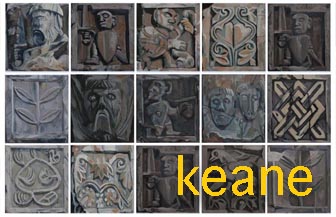 The Barga – Scottish connection is well known but this morning came news of yet another in the long list of links between the two cultures. Once again it was the designer, Mike Lemetti making headlines in some of the UK newspapers with another of his designer tartans. Mike, whose mother Emilia Biagi was born in Castelvecchio Pascoli and is related to the Ghiloni and Pellegrini families from this area, this time has made the news with his company, ClanItalia of Falkirk when he managed to get one of his tartan scarves around the shoulders of one the the most photographed person in the world – Pope Benedict XVI.
The Barga – Scottish connection is well known but this morning came news of yet another in the long list of links between the two cultures. Once again it was the designer, Mike Lemetti making headlines in some of the UK newspapers with another of his designer tartans. Mike, whose mother Emilia Biagi was born in Castelvecchio Pascoli and is related to the Ghiloni and Pellegrini families from this area, this time has made the news with his company, ClanItalia of Falkirk when he managed to get one of his tartan scarves around the shoulders of one the the most photographed person in the world – Pope Benedict XVI.
The plaid was made, in a limited run, by two Scottish textile firms: Ingles Buchan of Glasgow and ClanItalia of Falkirk.
As with every tartan, colors will play a symbolic role in the St. Ninian plaid dedicated to Benedict XVI.
The white line on blue field draws upon Scotland’s national colours while the green reflects the lichens growing on the stones of Whithorn in Galloway. It was there that St. Ninian first brought the Gospel of Jesus Christ to Scottish shores over 1,600 years ago.
The white lines are also accompanied by a pair of red lines, reflecting the colors of Cardinal Newman’s [who will be beatified by the Pope] crest. And finally, the thin yellow lines in the tartan, together with the white, reflect the colors of the Vatican.
In terms of the weaving, each white line on the green contains exactly eight threads, one for each Catholic diocese in Scotland. There are 452 threads in the design from pivot to pivot, representing the number of Catholic parishes.
Pope Benedict XVI became an honorary Scot on his historic visit yesterday – when he put on a Tartan scarf.
He delighted 125,000 well-wishers in Edinburgh by donning the plaid – after Cardinal Keith O’Brien smuggled it on to the Popemobile up his cassock.
The Pontiff proudly wore the scarf on a tour of the capital following a meeting with the Queen at Holyrood Palace. Last night a source said: “The fact Benedict was wearing the tartan was down to the Cardinal. He produced scarves for the Pope and his personal secretary Georg Ganswein out of his shirt when he got in the Popemobile with them.
no images were found
“They all wore them over their shoulders.
“If he’d asked for permission to do it beforehand, he probably wouldn’t have got it.”
Last night designer Michael Lemetti was delighted the Pope wore the St Ninian’s plaid he created for his visit.
Michael, 52 – who also owns a chippy in Falkirk – said: “It’s apparently the first time that the Pope has worn anything other than his official Papal uniform.
“I have Cardinal O’Brien to thank.
“All the world will have seen the Pope wearing my scarf around his neck.
“I’ve been involved in the creation of some high profile tartans, including a bespoke design for AC Milan, but this one tops the lot!
“The tartan looks brilliant and is full of fabulous Scottish symbolism
The Pope met the Queen and First Minister Alex Salmond and was later greeted by thronging crowds on the capital’s streets.
He then headed to Glasgow to give an open-air Mass to around 65,000 pilgrims at Bellahouston Park.
Michael Lemetti, a member of the textile firm, ClanItalia, said: “I’ve been involved in the creation of some high profile tartans, including a bespoke design for AC Milan, but this one tops the lot!
“The tartan looks brilliant and is full of fabulous Scottish symbolism. I’m sure Pope Benedict will love it.
Tartan Details – Italian National – Mike Lemetti is a third generation Scottish Italian – his forebears emigrated from Tuscany to Scotland in 1890 – and this tartan was designed to commemorate Scottish/Italian links and is for the use of Scots of Italian extraction. Approved by the Italian Consul in Glasgow. The design includes the colours of the Italian flag, black for the Pretorian Guard, Gold for the Roman Empire – all set against a background of Azzuri blue for the Italian national football team. The green, white, and red reflect the colours in the Italian flag. The tri-colours were adopted in honour of the uniforms worn by the Civic Militia of Milan which were predominantly green with some white. Red parts were added in 1796 when the Militia became the National Guard. The black in the Italian National Tartan reflects the Praetorian Guard. An elite force of palace guards established in the beginning of the Empire period, to guard the person and family of the Emperor. With its unique history, the guard still remains a symbol of strength and power. The gold represents the rich culture of the Roman Empire and the warmth and beauty of the Italian sunshine. These colours rest on a field of azzuro blue. The colour itself is bold and formidable, bringing forth images of the Mediterranean depths. It was selected in honour of the Italian National football team and embodies the love and support the Italian people have for their country. source – The Scottish Register of Tartans




